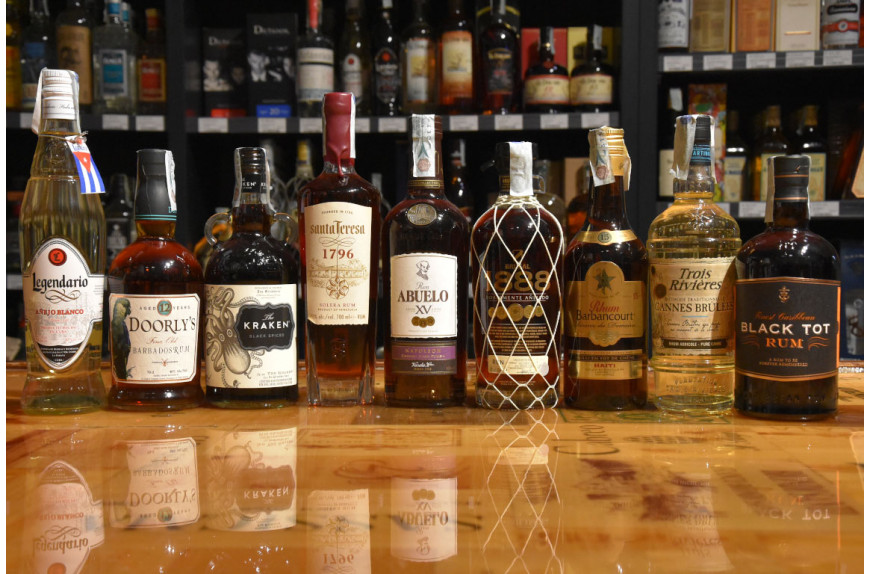Rum, Rhum, Ron: scoprilo all'Enoteca Alessi

Rum, Rhum, Ron: scoprilo all'Enoteca Alessi
Tags
Categorie
Il Rum è ottenuto distillando l'esito della fermentazione della canna da zucchero o della melassa, un prodotto della lavorazione dello zucchero.
Origini del Rum
Il primo Rum venne distillato nel XV secolo a Londra con le canne da zucchero indiane e in seguito con quelle delle Americhe.
Due secoli più tardi si ha la prima distillazione nelle Americhe, in alcune piantagioni di canna da zucchero dei Caraibi: secondo la tradizione, sull’Isola di Barbados.
Gli schiavi delle piantagioni furono i primi ad accorgersi che la melassa, scarto del processo di raffinazione dello zucchero, fermentava.
Al giorno d’oggi la produzione avviene in diversi paesi del mondo ma la maggior parte del Rum mondiale proviene comunque dai paesi caraibici.
I due stili del Rum
Il mondo del Rum si distingue in due stili di produzione: Industriale, o Tradizionale e Agricolo.
Il Rum Industriale (Ron) si produce dalla melassa che viene diluita e, con l'aggiunta dei lieviti, dà inizio alla fermentazione per poi essere quindi distillata.
Questo stile è tipico di paesi ex colonie spagnole e dà vita a distillati che si distinguono per note più morbide e tostate.
Il Rum Agricolo (Rhum Agricole) si produce unicamente dalla distillazione del succo puro di canna da zucchero, conosciuto come Vesou.
Questa tipologia viene prodotta nei paesi di tradizione francese.
Dal 1996 esiste anche la denominazione AOC Martinique associata alla Martinica, unica isola ad avere un marchio di origine.
Questo stile produttivo dà origine a Rum più secchi e di notevole finezza.
Il Processo produttivo parte dalla fermentazione della melassa o del vesou e ha una durata che va da un minimo di 24 ore ad un massimo di 15 giorni; segue la successiva la distillazione che può essere continua o discontinua a seconda del tipo di Rum che si vuole produrre.
L’invecchiamento viene effettuato in botti di secondo passaggio nelle quali prima è stato contenuto Bourbon o Whiskey Americano.
Può avvenire con metodo “solera”, un metodo di invecchiamento dinamico che consiste nel formare una piramide di botti: si riempiono per prime le botti più in alto, dopo il primo anno di invecchiamento parte del contenuto viene versato nelle botti che si trovano nella fila inferiore e quelle superiori vengono ricolmate con il rum della nuova annata.
Questo procedimento si ripete di anno in anno e così facendo le botti alla base avranno il rum pronto al consumo che sarà un blend ricco di profumi e sentori di diverse annate.
L’invecchiamento può avvenire anche in una sola botte che contiene la miscela di rum di annate differenti.
In tal caso sulla bottiglia verrà indicato il numero di anni dell’invecchiamento (es. 12 anni), riferendosi con esso o al rum più vecchio della miscela o al più giovane o alla media degli anni dei rum miscelati, a seconda della filosofia del produttore.
Quando vengono miscelati Rum di annate diverse e differenti anni d’invecchiamento abbiamo un Blended, se invece vengono miscelati rum di una sola annata e con gli stessi anni di invecchiamento abbiamo un Millesimato o Millèsimé.
Le varie tipologie di Rum
Bianco: il Rum bianco dopo la distillazione passa un breve periodo in botte che va generalmente dai 3 ai 12 mesi (alcune aziende lo lasciano anche più a lungo volendo dare la propria impronta al risultato finale), poi viene filtrato per riportarlo al colore trasparente.
Il risultato dà un Rum leggero e profumato che ben si presta anche alla miscelazione e quelli agricoli sono più corposi e ottimi da degustare in purezza.
Oro: il Rum oro è detto anche “ambrato” ed effettua un invecchiamento di 1-2 anni in botti che hanno contenuto il Bourbon.
La distillazione avviene in alambicchi a colonna e alcuni di questi Rum presentano un delicato aroma di vaniglia.
Scuro: il Rum scuro può avere una colorazione dall’ambrato al bruno in base al legno della botte di invecchiamento. In bocca predomina il caramello, il gusto è corposo e intenso.
I rum scuri distillati in alambicchi discontinui e lasciati invecchiare a lungo nei barili sono i più complessi.
Per intensificare la tonalità del colore, alcune aziende aggiungono caramello o melassa prima dell’imbottigliamento. Va degustato in purezza.
Invecchiato: il Rum invecchiato effettua una maturazione in botte di almeno 3 anni e può essere chiamato in vari modi a seconda della zona di produzione o della filosofia del produttore (es. Aged, añejo, dated, maturated, vieux).
I maestri di cantina seguono minuziosamente le miscelazioni di questa tipologia per garantire che il flavour dell’etichetta sia costante di anno in anno.
Overproof: il Rum overproof ha un titolo alcolometrico volumico molto alto che può raggiungere anche il 75%.
Viene usato maggiormente nella miscelazione dato che è molto difficile da degustare in purezza.
Speziato o Spiced: i Rum speziati sono distillati nei quali vengono infuse delle botaniche di origine vegetale (foglie, radici, semi) per dare aroma, colore e sapore; mentre come retrogusto principale possono avere vaniglia, cannella e limone.
Anche questi vengono molto utilizzati nella miscelazione, soprattutto nei long drink a base di frutta.
Le diverse tipologie del rhum agricolo
Il Rhum Agricole prodotto nelle Antille francesi segue delle regole di classificazione specifiche e ben distinte:
- Bianco: 3 mesi di invecchiamento e privo di colore.
- Rhum Agricole Paille o Ambrè: viene invecchiato per 1 anno in barili di rovere che hanno già contenuto Bourbon.
- Rhum Agricole Vieux o V.O.: effettua un invecchiamento di almeno 3 anni.
- Rhum VSOP: effettua un invecchiamento di almeno 4 anni.
- Rhum X.O.: effettua un invecchiamento di almeno 6 anni.
- Rhum Hors d’age: effettua un invecchiamento tra 8 e 12 anni.
- Rhum Vieux Agricole Millèsimé: effettua un invecchiamento di almeno 15 anni.
Ti aspettiamo in Enoteca per guidarti all'acquisto dei Rum più interessanti e, soprattutto, più adatti al tuo gusto e alle tue esigenze!
